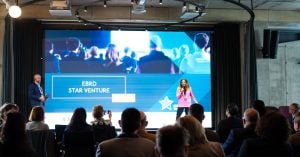People are guided by various motivations in both their professional and personal lives. When we talk about the professional sphere, there are three main categories of motivations: salary – which covers current expenses and drives us to work according to expectations; bonuses – which can finance holidays, cars, housing – in this case, employees are incentivized to go beyond expectations; and equity participation through ESOP, which has the potential to enrich employees. The latter form of motivation can be seen as holistic, contributing to the well-being of employees as well as the prosperity of the company. In this scenario, employees benefit from dividends if they are distributed, or from a share of profits when the company goes public or is acquired.
This way of rewarding employees transforms their perspective from one focused on improving their own skills to one oriented towards the overall success of the company. The ESOP encourages employees to go beyond their own specializations, to think beyond what they know how to do. For example, a programmer who knows someone who would be a perfect fit on the team may recommend them to HR or may attract new clients. Such initiatives can support the company’s growth, even if they don’t directly affect the employee’s salary.
From the very beginning, it is ideal for entrepreneurs to consider ESOP tools
Initiatives of this kind are common in the technology sector, where we are seeing rapid company growth. The model appeared in the United States in 1956 and with the rise of
Microsoft – in the early 1980s – it boomed. There are well-known stories of employees who, having been paid in shares instead of cash because of the company’s financial restrictions, have accumulated greater fortunes than some managers. Many of Microsoft’s early employees became multimillionaires in dollars because of this benefit. So the model originally adopted in the US crossed the Atlantic about ten years ago to Western Europe and is now starting to gain ground across Europe.
I think it’s always a good time for a company to offer such rewards to employees. The question for entrepreneurs is how extensive this plan will be – whether they want to include all employees as shareholders or just a selection of them. But it is clear that from the beginning it should be considered an ESOP tool, as it is extremely valuable for both the employee and the company. For employees, it represents a substantial income prospect, unavailable through salary or bonuses.
The company will benefit from increased attachment and motivation from employees, who will no longer see the organization only as a source of salary and benefits. They suddenly gain both the perspective of an employee and that of a co-owner. They begin to understand aspects of the company much more deeply, not just logically, but emotionally, thinking: “It’s my company too, and together we want it to do well”.
So we’re not talking about large percentages of shares on offer, we’re talking about numbers. As a rule, the percentages given to employees are minimal, for example 0.1% of the company. It is not about giving significant percentages to a limited number of people, but about distributing as many shares as possible.
In general, there are two models of ESOPs: every person in the company can own shares, motivating everyone to excel, or only certain categories – either management (or from a certain level upwards) or a department. There are also approaches whereby sales specialists might benefit more from bonuses and less from ESOPs, as they are often seen as motivated by immediate and tangible benefits. This being the case, the stock option would be reserved for those whose contribution to the good of the company is more difficult to quantify.
The ESOP concept is well understood in Romania; the challenge is to fully understand its implications
Romanians are increasingly open to the concept. We are seeing a growing number of entrepreneurs and companies interested in implementing the scheme, as well as informed consultants able to develop a plan from a business, legal and tax perspective. It is essential that all these elements – business, legal and tax – be considered. I believe that in the coming years we will see more collaboration between tax advisers, lawyers and business people to build such plans.
The ESOP concept is clear and accessible in Romania; I don’t know anyone who doesn’t understand what it is all about. However, the challenge remains in understanding all the implications. There is often a gap between the idea of implementing an ESOP plan and actually executing it. I’ve met hundreds of entrepreneurs and companies who say, “Yes, we want to implement an ESOP. How do we start?”. They start by hiring a lawyer, who asks questions that entrepreneurs can’t answer. Lawyers can offer solutions related to logistics and legal issues, but the business implications often remain a question mark. Implementing an ESOP doesn’t take long if you have answers to questions, but it does require some quiet time to ponder the implications of the answers provided.
When the entrepreneur postpones signing for “when we have time” it may lead to complications later on
Thus, the ESOP implementation effort becomes more difficult to manage than the immediate need. When the entrepreneur says: “I’ll talk to the people now, we’ll leave the signature for later, when we have time”, he risks postponing indefinitely. Free time is not easily found, and the longer the delay, the more complicated the process becomes.
Although the world accepts and understands the philosophical value of the ESOP, entrepreneurs and managers often find it difficult to open their wallets and sign their papers. The question “If this employee leaves in five years, what happens? Will he stay with shares in the company?” is ever-present. The answer is yes.
I’ve noticed that people are basically happy to share success. But they fear that they will have to share the benefits even when they are not successful, and they feel that others are profiting too early. ESOPs can be structured in such a way as to allay these fears, so that they no longer have to worry about getting into trouble if an employee is unhappy and refuses to sign the AGM (Annual General Meeting).
ESOP developed in Romania thanks to UiPath and the ESOP law
The most eloquent example of successful ESOPs in Romania is UiPath. We have all read about the significant number of employees who have become multi-millionaires in dollars thanks to UiPath. It is the most triumphant Romanian success story in this field.
I had the privilege of being well connected to the American business environment and observed the functioning of ESOP. Within the Gecad group, we implemented this system 25 years ago. As a result, employees developed a sense of belonging and continued to work together because they understood what success meant, experienced it and tried to replicate the same principles in other contexts. They created inclusive cultures in their new work environments. Entire teams that had worked together at Gecad chose to regroup at other corporations such as Intel or Lenovo, perpetuating inclusive cultures, both among themselves and in collaboration with these corporations. Not to mention the personal satisfaction of seeing dozens of people earn significantly more than they would have through salary. It’s a spectacular achievement, absolutely impressive.
Unquestionably, UiPath has been a catalyst in this direction. The combination of UiPath’s success and the adoption of ESOP legislation in Romania were the two forces that drove this concept forward. This ESOP “idea” has been set in motion with remarkable speed. We see the same trends in all European countries, unicorns and legislative adaptation to encourage the extension of benefits to new generations.








